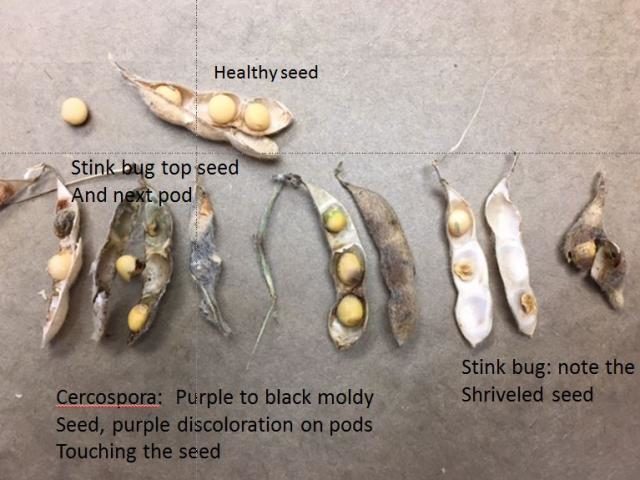By Anne Dorrance, Soybean Pathologist; Andy Michel, Associate Professor and Interim Associate Chair
Poor seed quality from Phomopsis/Diaporthe, purplish colored seed and seed coat mottling were reported over the past few weeks from a few fields. These are more critical for our food grade and seed producers but to date should not affect feed quality. These fungi have not been reported to this extent in Ohio for some time. I will comment on the problems from fungi here today.
1. Phomopsis-Diaporthe Seed Complex
This is the white, chalky-appearing seed that is found in some seed lots. Seed infection from these fungi occurs first on SUSCEPTIBLE varieties, second when wet rainy weather occurs during and following pod fill, and in association with high feeding levels from bean leaf beetle. The susceptibility of the variety is a key component of this complex. It has been a very long time (back in the ‘70s) since this disease complex was studied here at OSU. We have probably only had one other wet fall where we had high levels of seed infections.
2. Fields Where We Had Diaporthe Stem Canker
Yes, we also had this disease show up in a few places this year. In these fields we also are hearing reports of seed quality issues.
What to do with this seed now — sell it. Unlike corn or wheat, the feed quality is not affected, but if the seed is not kept dry, the fungus will continue to colonize the grain. This follows the “one bad apple can spoil a whole bunch,” but only if the environment continues to favor colonization of the seeds.
What to do for those fields that had high levels of disease? I am fully aware that some of you don’t like this message — but this fungus survives on residue, so anything you do to help that residue to decay faster will be great. If the residue is there the next time you plant soybeans, then yes, you will be fighting this disease again, and no there are no good fungicide recommendations for this.
When you are ready to go back in with soybean, choose a variety that has resistance. Here’s the thing — we don’t look at Phomopsis on northern varieties like we used to, because this disease has not been reported here for a long time. We don’t have field sites that are loaded with inoculum, which would occur from irrigation through the late summer to enhance the infection process. This is one disease we probably need to begin to take a closer look at on our northern varieties. This year, in parts of the state where there were steady rains during pod fill, provided for the best screening we have had in a long time.
3. Purple Seed
 Stink bug damage on top seed, but purple seed stain and marks on petiole indicative of Cercospora.
Stink bug damage on top seed, but purple seed stain and marks on petiole indicative of Cercospora.
4. Purple Seed Stain
This is due to some weeds that have juicy berries mingling with the healthy seed during the harvest process. I’ve got a real issue with this myself in one of our field plots where we had black nightshade take over. There are other weeds as well that can do this.
Again, this is going to affect our food grade producers more than others. Seed with the fungus should be sold for feed — it won’t hurt the feed quality, but it will affect germination.
5. Insects Can Sometimes Affect Seed Quality
The two main culprits are bean leaf beetles and stink bugs. Bean leaf beetles will chew on the pods, especially in late-planted soybeans. This chewing will sometimes reach the seeds, causing direct damage, but can also impact quality indirectly. The open feeding damage makes the pod more vulnerable to diseases such as Phomopsis or other fungi. In addition, bean leaf beetles can also transmit bean pod mottle virus, which causes a dark mosaic pattern on the seed.
Stink bug feeding usually causes a shriveled or flattened seed, although some discoloration is also seen, it tends to be more black or brown than purple. It is difficult to differentiate from these two types of feeding, although inspecting pods might provide a clue if there is evidence of chewing damage typical of bean leaf beetle. Stink bugs feed by piercing and sucking, and sometimes their puncture holes are too small to be seen. However, we have observed both within fields and from samples, both insects were present and contributing to injury.






